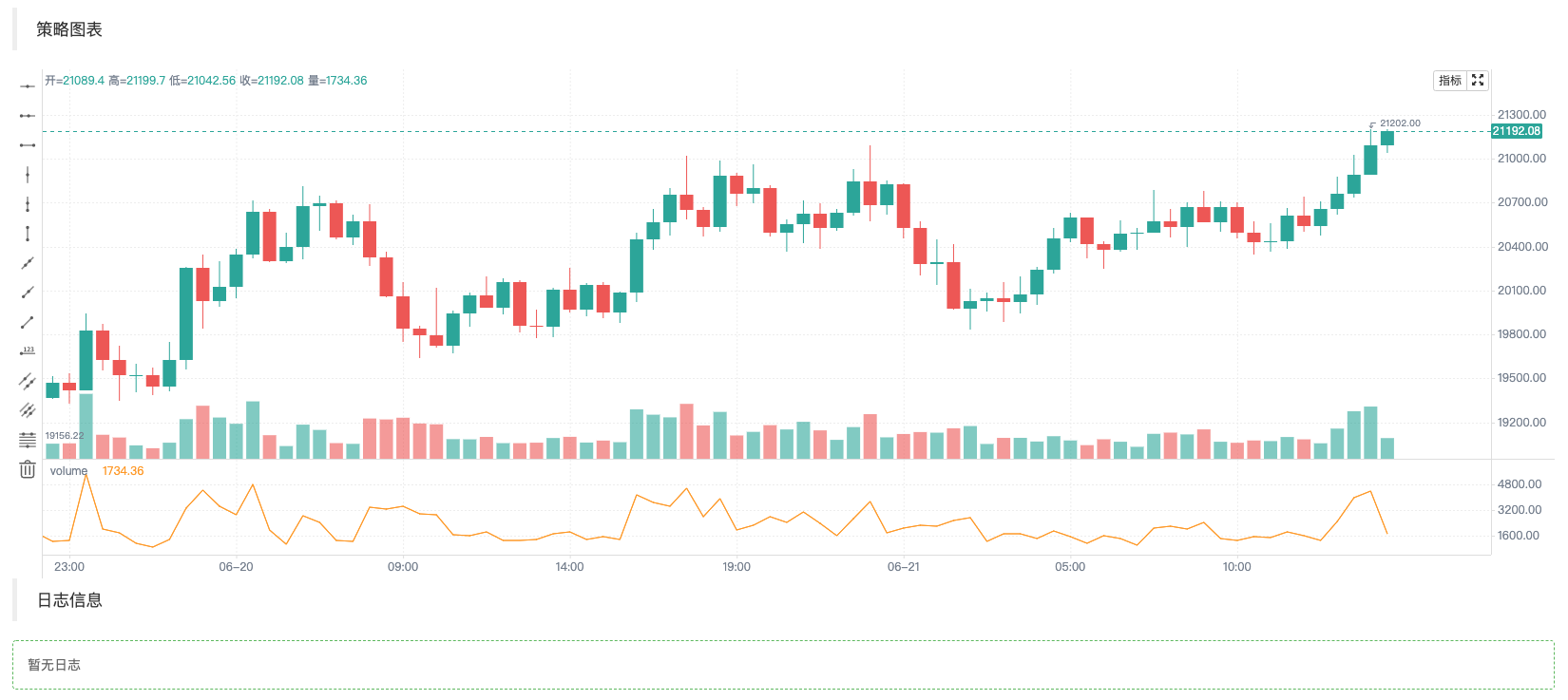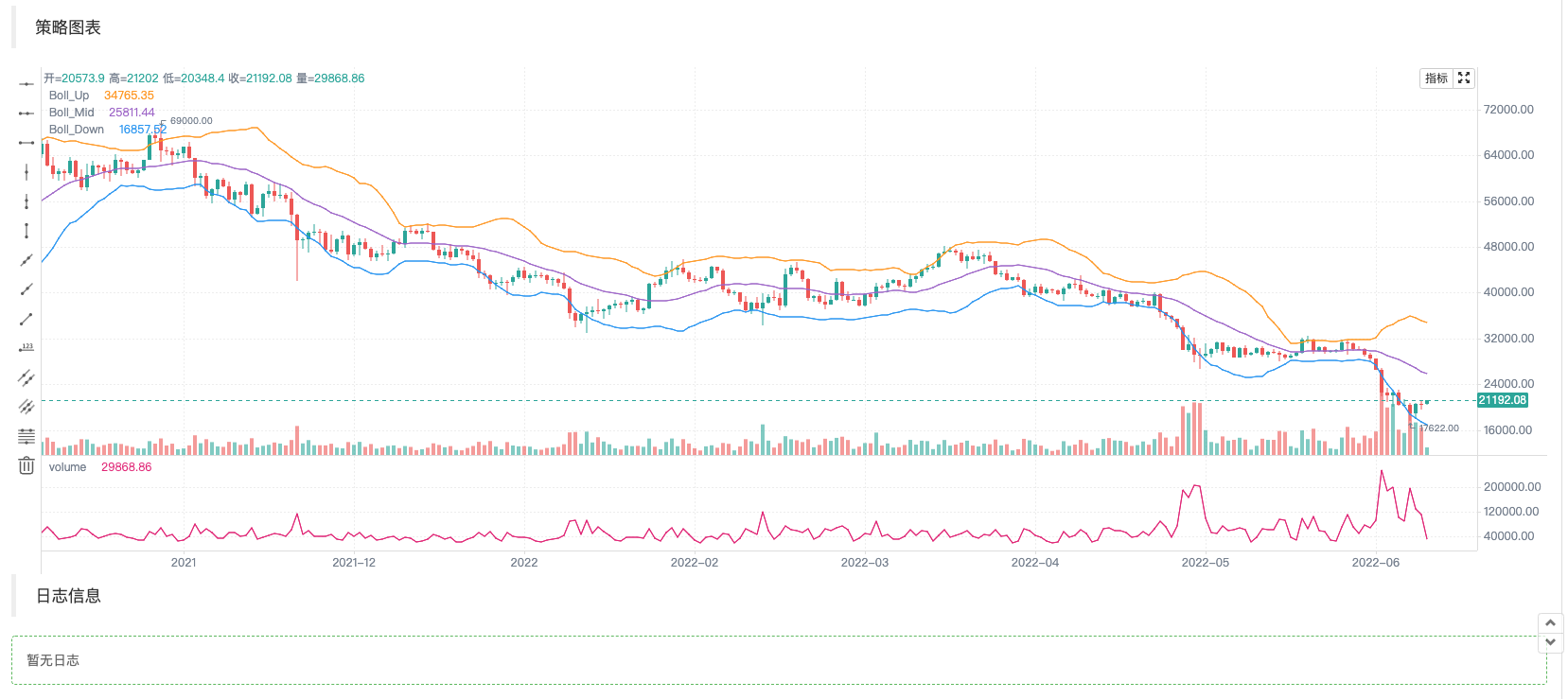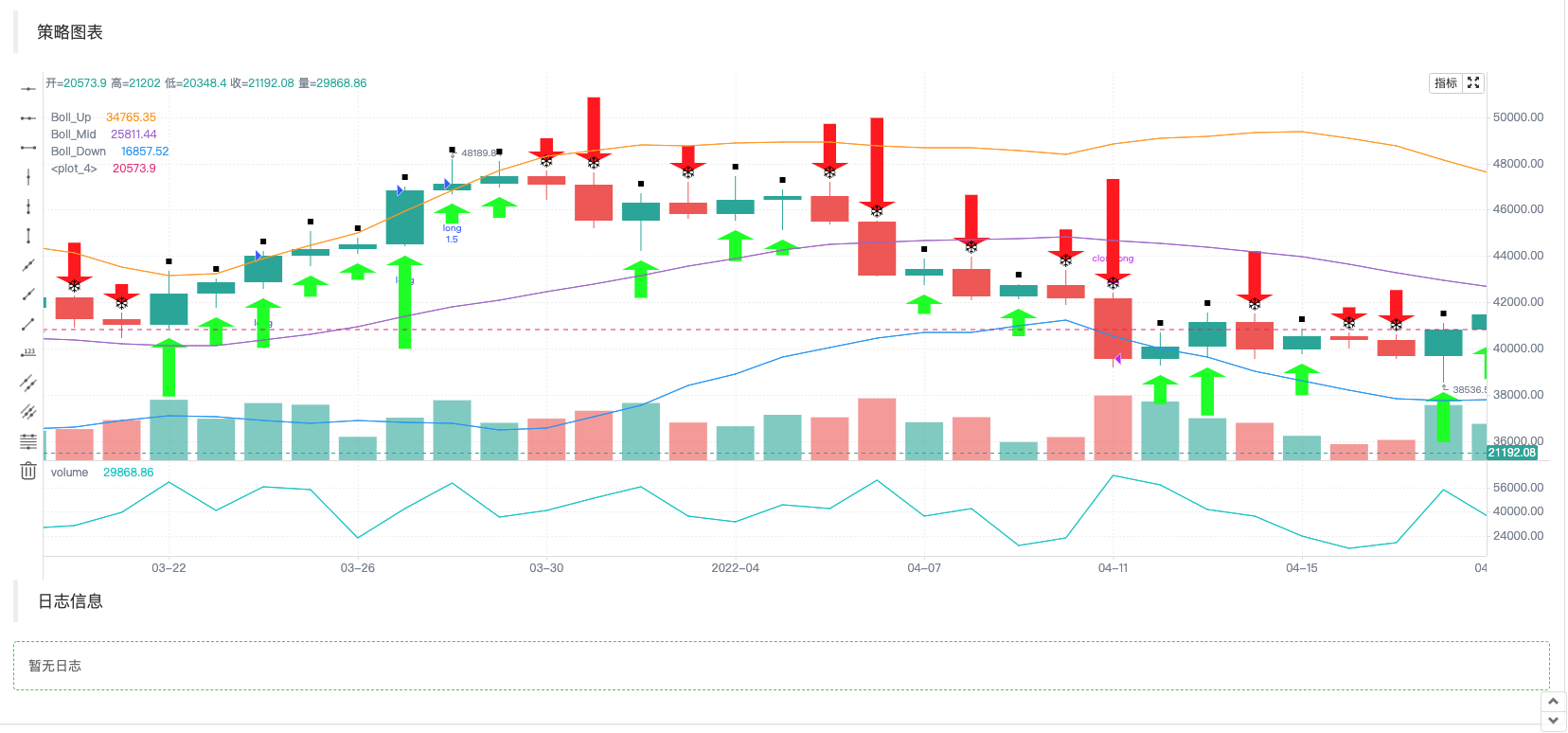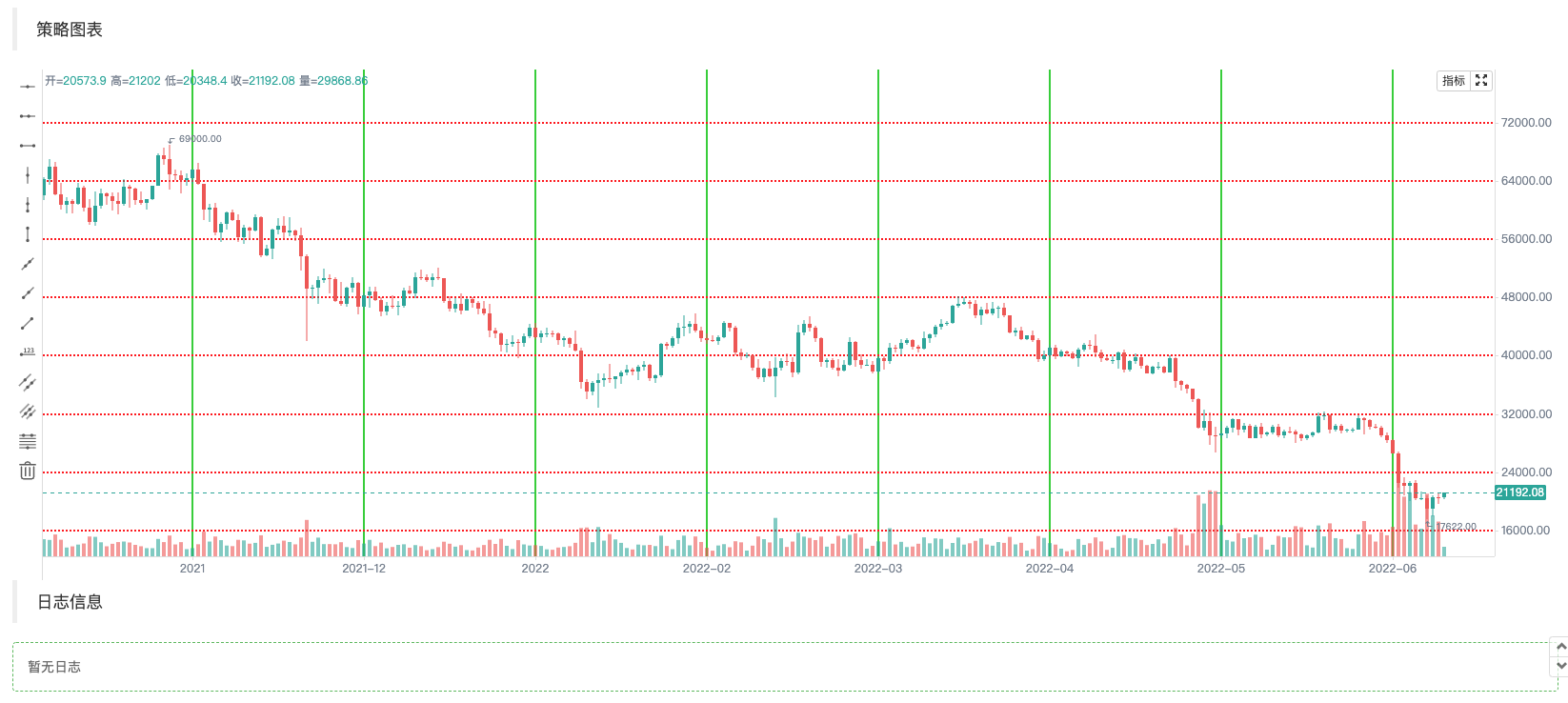Use the KlineChart function to simplify strategy chart design
Author: The Little Dream, Created: 2022-07-01 15:54:06, Updated: 2023-09-18 20:11:05
Use the KlineChart function to simplify strategy chart design
When designing a policy chart, it is often necessary to design a policy chart. When writing a policy chart using the JavaScript language, the Python language. Users who are unfamiliar with programming or the chart library used by the FMZ platform often struggle with designing a custom chart. So how can you draw a rich policy chart with only a small amount of code?
This simple and powerful graphical design can be seen in the Pine language, which is known for its rich graphics capabilities. If the graphics interface of the Pine language can be used to access the JavaScript, Python, and Python strategies, it greatly facilitates the graphics capabilities of the developer's design strategy.KLineChartHow the function performs custom graph drawing.https://www.fmz.com/api#klinechart
Let's write a simple example of a transition using JavaScript.
A simple example
/*backtest
start: 2022-03-21 09:00:00
end: 2022-06-21 15:00:00
period: 30m
basePeriod: 15m
exchanges: [{"eid":"Binance","currency":"BTC_USDT"}]
*/
function main() {
var c = KLineChart()
while (true) {
var bars = _C(exchange.GetRecords)
for (var i = 0 ; i < bars.length ; i++) {
var bar = bars[i]
c.begin(bar)
c.plot(bar.Volume, "volume")
c.close()
}
Sleep(1000)
}
}
The example is very simple, simply drawing a line K in the custom graph area of the strategy, and drawing a transaction curve at the subgraph location of the graph corresponding to each K line BAR.

We're going to use the first thing in the code.var c = KLineChart()Create a graph object, which is then used to call its method to draw a graph. Then, in the loop, we get the K-line data (the array structure) and run operations on the K-line array.
The graph operation is fromc.begin(bar)The function starts.c.close()The function is terminated.begin、closeFunctions are methods for graph objects c. The most commonly used graph functions are used next.plotDraw a traffic curve on each BAR.
A bit more complicated example
If we want to design a graph with a Brin indicator attached. Oh yeah! and we want to attach a transaction line graph for each BAR, we can design it like this:
/*backtest
start: 2022-03-21 09:00:00
end: 2022-06-21 15:00:00
period: 1d
basePeriod: 1h
exchanges: [{"eid":"Binance","currency":"BTC_USDT"}]
*/
function main() {
var c = KLineChart()
// 策略主循环
while(true) {
// 轮询间隔
Sleep(500)
// 获取K线数据
let bars = exchange.GetRecords()
if (!bars || bars.length <= 20) {
continue
}
// 计算布林指标
var boll = TA.BOLL(bars)
bars.forEach(function(bar, index) {
c.begin(bar)
// 画图操作
c.plot(boll[0][index], "Boll_Up", {overlay: true}) // 画在图表主图
c.plot(boll[1][index], "Boll_Mid", {overlay: true}) // 画在图表主图
c.plot(boll[2][index], "Boll_Down", {overlay: true}) // 画在图表主图
c.plot(bar.Volume, "volume") // 画在图表副图
c.close()
})
// 策略交易逻辑
// ...
// ..
}
}
As you can see in the code, the configuration information for the re-measurement we did on the FMZ platform is:
/*backtest
start: 2022-03-21 09:00:00
end: 2022-06-21 15:00:00
period: 1d
basePeriod: 1h
exchanges: [{"eid":"Binance","currency":"BTC_USDT"}]
*/
This configuration is called a Binance spot exchange object retest test, and the retest results are as follows:

As you can see, we're using the diagramming method of Pine to greatly simplify the diagramming code in JavaScript.
Write data graphs such as indicators
Obtaining K-line data, calculating indicators, and these operations are common and very simple in the strategy paradigm and API documentation of Platform Strategy Square.
// 获取K线数据
let bars = exchange.GetRecords()
if (!bars || bars.length <= 20) {
// 如果获取K线失败,即!bar为真则执行continue,忽略之后的代码,重新执行循环
// 如果bars.length小于等于20,即K线BAR(柱)数量小于20,无法计算指标,也执行continue
continue
}
// 计算布林指标
var boll = TA.BOLL(bars)
布林指标计算函数TA.BOLL,如果不指定布林指标参数,就使用默认参数BOLL(20, 2)│Boll indicator has three lines, so the data returned by the TA.BOLL function is a two-dimensional array│boll[0],boll[1],boll[2] or three elements of theboll array, each representing a line, an array│
- boll[0]: Brin is online
- boll[1]: middle line of the Boll belt
- boll[2]: Boll band downline
Then we'll see how to plot the volume of the K-line data into the volume of the transaction, and the calculated Brin indicator data onto the graph.
We're plotting the K-line data Bar by Bar, so we're going to go through the entire K-line array, which is the array of bars in the code.forEachThe method can be traversed, or it can be traversed using the for loop.
bars.forEach(function(bar, index) {
c.begin(bar)
// 画图操作
c.plot(boll[0][index], "Boll_Up", {overlay: true}) // {overlay: true}参数控制,画在图表主图
c.plot(boll[1][index], "Boll_Mid", {overlay: true}) // 画在图表主图
c.plot(boll[2][index], "Boll_Down", {overlay: true}) // 画在图表主图
c.plot(bar.Volume, "volume") // 画在图表副图
c.close()
})
Note that every time you start drawing a chart on a Bar, you first do this.c.begin(bar)It's called a function.beginThe function is a method of our graph object c. At the end of the drawing operation, it needs to be calledc.close()I'm here.beginFunctions andcloseIn between the functions is a drawing function that we call similar to the drawing method of the Pine language.barcolor bgcolor plot fill hline plotarrow plotshape plotchar plotcandle signalThe parameters of these functions are consistent with the parameters of the corresponding function in the Pine language, and the graphic functions are also consistent.
Adding graphics such as trading signal arrows, markers, horizontal lines
In the illustration example of the Brin indicator above, some trading signal arrows, markers, horizontal lines are added.
/*backtest
start: 2022-03-21 09:00:00
end: 2022-06-21 15:00:00
period: 1d
basePeriod: 1h
exchanges: [{"eid":"Binance","currency":"BTC_USDT"}]
*/
function main() {
var c = KLineChart()
// 策略主循环
while(true) {
// 轮询间隔
Sleep(500)
// 获取K线数据
let bars = exchange.GetRecords()
if (!bars || bars.length <= 20) {
continue
}
// 计算布林指标
var boll = TA.BOLL(bars)
bars.forEach(function(bar, index) {
c.begin(bar)
// 画图操作
c.plot(boll[0][index], "Boll_Up", {overlay: true}) // 画在图表主图
c.plot(boll[1][index], "Boll_Mid", {overlay: true}) // 画在图表主图
c.plot(boll[2][index], "Boll_Down", {overlay: true}) // 画在图表主图
c.plot(bar.Volume, "volume") // 画在图表副图
c.hline(bar.Open, {overlay: true}) // 水平线
c.plotarrow(bar.Close - bar.Open, {overlay: true}) // 箭头
c.plotshape(bar.Close - bar.Open > 0, {style: 'square', overlay: true}) // 画方块标记
c.plotchar(bar.Close - bar.Open < 0, {char: '❄', size: "20px", overlay: true}) // 画出字符❄
if (boll[0][index] && bar.Close > boll[0][index]) {
c.signal("long", bar.Close, 1.5)
} else if (boll[2][index] && bar.Close < boll[2][index]) {
c.signal("closelong", bar.Close, 1.5)
}
c.close()
})
// 策略交易逻辑
// ...
// ..
}
}

Since the command-line operations in the Pine language automatically mark signals on the graph, theKLineChartThe graph object created by the function also extends a function used to draw buy-sell signals:c.signal。
Chart configuration objects
A structure can be declared to configure the chart style, for example, the following chartCfg variable represents the configuration information of a grid line.
var chartCfg = {
grid: {
show: true,
// 网格水平线
horizontal: {
show: true,
size: 2,
color: '#FF0000', // 水平网格线的颜色
// 'solid'|'dash'
style: 'dash', // 线的类型
dashValue: [2, 2]
},
// 网格垂直线
vertical: {
show: true,
size: 2,
color: '#32CD32',
// 'solid'|'dash'
style: 'solid',
dashValue: [2, 2]
}
},
}
Chart configuration objects are the data structures for which some properties, appearances, etc. of the chart are set, such as the configuration of a grid style used in the example. There are many options that can be configured and modified, such as the related settings of the X-axis, Y-axis, setting of the beamline, setting of the prompt, setting of the style of the technical indicator, setting of the style of the K-line BAR, etc.
Of course, if you're not familiar with these, you're callingKLineChartWhen a function creates a graph object, it cannot pass the graph configuration object. The graph is then created in the default style. The FMZ platform uses API functions.KLineChartThe function creates graph objects:
var c = KLineChart(chartCfg)
Draw the test code for the grid line:
/*backtest
start: 2022-03-21 09:00:00
end: 2022-06-21 15:00:00
period: 1d
basePeriod: 1h
exchanges: [{"eid":"Binance","currency":"BTC_USDT"}]
*/
function main() {
var chartCfg = {
grid: {
show: true,
// 网格水平线
horizontal: {
show: true,
size: 2,
color: '#FF0000',
// 'solid'|'dash'
style: 'dash',
dashValue: [2, 2]
},
// 网格垂直线
vertical: {
show: true,
size: 2,
color: '#32CD32',
// 'solid'|'dash'
style: 'solid',
dashValue: [2, 2]
}
},
}
var c = KLineChart(chartCfg)
// 策略主循环
while(true) {
// 轮询间隔
Sleep(500)
// 获取K线数据
var bars = _C(exchange.GetRecords)
bars.forEach(function(bar, index) {
c.begin(bar)
c.close()
})
// 策略交易逻辑
// ...
// ..
}
}

Chart configuration style examples
It can be used to refer to the configuration style of the chart.
{
// 网格线
grid: {
show: true,
// 网格水平线
horizontal: {
show: true,
size: 1,
color: '#393939',
// 'solid'|'dash'
style: 'dash',
dashValue: [2, 2]
},
// 网格垂直线
vertical: {
show: false,
size: 1,
color: '#393939',
// 'solid'|'dash'
style: 'dash',
dashValue: [2, 2]
}
},
// 蜡烛图
candle: {
// 蜡烛图上下间距,大于1为绝对值,大于0小余1则为比例
margin: {
top: 0.2,
bottom: 0.1
},
// 蜡烛图类型 'candle_solid'|'candle_stroke'|'candle_up_stroke'|'candle_down_stroke'|'ohlc'|'area'
type: 'candle_solid',
// 蜡烛柱
bar: {
upColor: '#26A69A',
downColor: '#EF5350',
noChangeColor: '#888888'
},
// 面积图
area: {
lineSize: 2,
lineColor: '#2196F3',
value: 'close',
backgroundColor: [{
offset: 0,
color: 'rgba(33, 150, 243, 0.01)'
}, {
offset: 1,
color: 'rgba(33, 150, 243, 0.2)'
}]
},
priceMark: {
show: true,
// 最高价标记
high: {
show: true,
color: '#D9D9D9',
textMargin: 5,
textSize: 10,
textFamily: 'Helvetica Neue',
textWeight: 'normal'
},
// 最低价标记
low: {
show: true,
color: '#D9D9D9',
textMargin: 5,
textSize: 10,
textFamily: 'Helvetica Neue',
textWeight: 'normal',
},
// 最新价标记
last: {
show: true,
upColor: '#26A69A',
downColor: '#EF5350',
noChangeColor: '#888888',
line: {
show: true,
// 'solid'|'dash'
style: 'dash',
dashValue: [4, 4],
size: 1
},
text: {
show: true,
size: 12,
paddingLeft: 2,
paddingTop: 2,
paddingRight: 2,
paddingBottom: 2,
color: '#FFFFFF',
family: 'Helvetica Neue',
weight: 'normal',
borderRadius: 2
}
}
},
// 提示
tooltip: {
// 'always' | 'follow_cross' | 'none'
showRule: 'always',
// 'standard' | 'rect'
showType: 'standard',
labels: ['时间', '开', '收', '高', '低', '成交量'],
values: null,
defaultValue: 'n/a',
rect: {
paddingLeft: 0,
paddingRight: 0,
paddingTop: 0,
paddingBottom: 6,
offsetLeft: 8,
offsetTop: 8,
offsetRight: 8,
borderRadius: 4,
borderSize: 1,
borderColor: '#3f4254',
backgroundColor: 'rgba(17, 17, 17, .3)'
},
text: {
size: 12,
family: 'Helvetica Neue',
weight: 'normal',
color: '#D9D9D9',
marginLeft: 8,
marginTop: 6,
marginRight: 8,
marginBottom: 0
}
}
},
// 技术指标
technicalIndicator: {
margin: {
top: 0.2,
bottom: 0.1
},
bar: {
upColor: '#26A69A',
downColor: '#EF5350',
noChangeColor: '#888888'
},
line: {
size: 1,
colors: ['#FF9600', '#9D65C9', '#2196F3', '#E11D74', '#01C5C4']
},
circle: {
upColor: '#26A69A',
downColor: '#EF5350',
noChangeColor: '#888888'
},
// 最新值标记
lastValueMark: {
show: false,
text: {
show: false,
color: '#ffffff',
size: 12,
family: 'Helvetica Neue',
weight: 'normal',
paddingLeft: 3,
paddingTop: 2,
paddingRight: 3,
paddingBottom: 2,
borderRadius: 2
}
},
// 提示
tooltip: {
// 'always' | 'follow_cross' | 'none'
showRule: 'always',
// 'standard' | 'rect'
showType: 'standard',
showName: true,
showParams: true,
defaultValue: 'n/a',
text: {
size: 12,
family: 'Helvetica Neue',
weight: 'normal',
color: '#D9D9D9',
marginTop: 6,
marginRight: 8,
marginBottom: 0,
marginLeft: 8
}
}
},
// x轴
xAxis: {
show: true,
height: null,
// x轴线
axisLine: {
show: true,
color: '#888888',
size: 1
},
// x轴分割文字
tickText: {
show: true,
color: '#D9D9D9',
family: 'Helvetica Neue',
weight: 'normal',
size: 12,
paddingTop: 3,
paddingBottom: 6
},
// x轴分割线
tickLine: {
show: true,
size: 1,
length: 3,
color: '#888888'
}
},
// y轴
yAxis: {
show: true,
width: null,
// 'left' | 'right'
position: 'right',
// 'normal' | 'percentage' | 'log'
type: 'normal',
inside: false,
reverse: false,
// y轴线
axisLine: {
show: true,
color: '#888888',
size: 1
},
// y轴分割文字
tickText: {
show: true,
color: '#D9D9D9',
family: 'Helvetica Neue',
weight: 'normal',
size: 12,
paddingLeft: 3,
paddingRight: 6
},
// y轴分割线
tickLine: {
show: true,
size: 1,
length: 3,
color: '#888888'
}
},
// 图表之间的分割线
separator: {
size: 1,
color: '#888888',
fill: true,
activeBackgroundColor: 'rgba(230, 230, 230, .15)'
},
// 十字光标
crosshair: {
show: true,
// 十字光标水平线及文字
horizontal: {
show: true,
line: {
show: true,
// 'solid'|'dash'
style: 'dash',
dashValue: [4, 2],
size: 1,
color: '#888888'
},
text: {
show: true,
color: '#D9D9D9',
size: 12,
family: 'Helvetica Neue',
weight: 'normal',
paddingLeft: 2,
paddingRight: 2,
paddingTop: 2,
paddingBottom: 2,
borderSize: 1,
borderColor: '#505050',
borderRadius: 2,
backgroundColor: '#505050'
}
},
// 十字光标垂直线及文字
vertical: {
show: true,
line: {
show: true,
// 'solid'|'dash'
style: 'dash',
dashValue: [4, 2],
size: 1,
color: '#888888'
},
text: {
show: true,
color: '#D9D9D9',
size: 12,
family: 'Helvetica Neue',
weight: 'normal',
paddingLeft: 2,
paddingRight: 2,
paddingTop: 2,
paddingBottom: 2,
borderSize: 1,
borderColor: '#505050',
borderRadius: 2,
backgroundColor: '#505050'
}
}
},
// 图形
shape: {
point: {
backgroundColor: '#2196F3',
borderColor: '#2196F3',
borderSize: 1,
radius: 4,
activeBackgroundColor: '#2196F3',
activeBorderColor: '#2196F3',
activeBorderSize: 1,
activeRadius: 6
},
line: {
// 'solid'|'dash'
style: 'solid'
color: '#2196F3',
size: 1,
dashValue: [2, 2]
},
polygon: {
// 'stroke'|'fill'
style: 'stroke',
stroke: {
// 'solid'|'dash'
style: 'solid',
size: 1,
color: '#2196F3',
dashValue: [2, 2]
},
fill: {
color: 'rgba(33, 150, 243, 0.1)'
}
},
arc: {
// 'stroke'|'fill'
style: 'stroke',
stroke: {
// 'solid'|'dash'
style: 'solid',
size: 1,
color: '#2196F3',
dashValue: [2, 2]
},
fill: {
color: '#2196F3'
}
},
text: {
style: 'fill',
color: '#2196F3',
size: 12,
family: 'Helvetica Neue',
weight: 'normal',
offset: [0, 0]
}
},
annotation: {
// 'top' | 'bottom' | 'point'
position: 'top',
offset: [20, 0]
symbol: {
// 'diamond' | 'circle' | 'rect' | 'triangle' | 'custom' | 'none'
type: 'diamond',
size: 8,
color: '#2196F3',
activeSize: 10,
activeColor: '#FF9600'
}
},
tag: {
// 'top' | 'bottom' | 'point'
position: 'point',
offset: 0,
line: {
show: true,
style: LineStyle.DASH,
dashValue: [4, 2],
size: 1,
color: '#2196F3'
},
text: {
color: '#FFFFFF',
backgroundColor: '#2196F3',
size: 12,
family: 'Helvetica Neue',
weight: 'normal',
paddingLeft: 2,
paddingRight: 2,
paddingTop: 2,
paddingBottom: 2,
borderRadius: 2,
borderSize: 1,
borderColor: '#2196F3'
},
mark: {
offset: 0,
color: '#FFFFFF',
backgroundColor: '#2196F3',
size: 12,
family: 'Helvetica Neue',
weight: 'normal',
paddingLeft: 2,
paddingRight: 2,
paddingTop: 2,
paddingBottom: 2,
borderRadius: 2,
borderSize: 1,
borderColor: '#2196F3'
}
}
}
This is a great way to make the strategy graphic design easier!
- Quantifying Fundamental Analysis in the Cryptocurrency Market: Let Data Speak for Itself!
- Quantified research on the basics of coin circles - stop believing in all kinds of crazy professors, data is objective!
- The inventor of the Quantitative Data Exploration Module, an essential tool in the field of quantitative trading.
- Mastering Everything - Introduction to FMZ New Version of Trading Terminal (with TRB Arbitrage Source Code)
- Get all the details about the new FMZ trading terminal (with the TRB suite source code)
- FMZ Quant: An Analysis of Common Requirements Design Examples in the Cryptocurrency Market (II)
- How to Exploit Brainless Selling Bots with a High-Frequency Strategy in 80 Lines of Code
- FMZ quantification: common demands on the cryptocurrency market design example analysis (II)
- How to exploit brainless robots for sale with high-frequency strategies of 80 lines of code
- FMZ Quant: An Analysis of Common Requirements Design Examples in the Cryptocurrency Market (I)
- FMZ quantification: common demands of the cryptocurrency market design instance analysis (1)